“Civilization looks upon such exhibitions probably in the same light as the Romans looked upon their holidays, when gladiators met in the arena to split skulls.”
— The Florida Metropolis, a Jacksonville evening newspaper, 1917
— “Professor” Reddish wowed his fans by riding down a ramp and diving off a pier into the sea.
— A.M. “Max” Schreyer, known as “Daredevil” Schreyer, would cycle down a chute, propel himself from the bicycle just before it left the chute and dive into a tank of water.
— French-born Mademoiselle D’Zizi, like Schreyer, rode a bicycle down a steep ramp curved upward at the end and jumped over six elephants to a ramp on the other side of the pachyderms. The feat was billed as “a Dare Devil Ride Above a Yawning Death Arch.”
— Conn Baker of Columbus, Ohio, known as “Diavolo,” Italian for devil, was said to be the first person to perfect a “loop-the-loop” using a safety bicycle for the Adam Forepaugh & Sells Bros. Circus, which called the stunt “the veritable cap-sheaf of all hazardous exploits.”
 — Charles H. Kabrich, who billed himself as “the only bike-chute aeronaut,” ascended by balloon astride a bicycle and then parachuted back to earth while performing acrobatics on the bike.
— Charles H. Kabrich, who billed himself as “the only bike-chute aeronaut,” ascended by balloon astride a bicycle and then parachuted back to earth while performing acrobatics on the bike.Whenever a new means of human conveyance came along — the hot-air balloon, the automobile, the aeroplane — daredevils stepped forward to push the new contraption to its limits, and usually make some money doing it.
From the 1890s into the early 20th century, the machine of choice was the bicycle.
These daring entrepreneurs were celebrated in their time, but are almost completely forgotten today.
I first learned of their existence while trolling the Internet for vintage bicycle advertisements to display on this blog. I came across an 1896 poster of Kabrich performing his “novel and thrilling bicycle parachute act,” became intrigued and began looking for others like him. (See April 14 post, “The bike-chute aeronaut.”)
So far, I’ve found information on Reddish, Schreyer, D’Zizi, Baker and Kabrich. But I’m sure there were many more such bicycling daredevils.
— “Professor” Reddish, whose first name eludes me, was a specialist in a stunt called “flying the foam,” which he performed regularly in the first decade of the 20th century in Brighton, a resort town on England’s south coast. The stunt involved riding a bicycle down a steep ramp and then off the end of Brighton’s West Pier into the sea. Archive footage from the British Film Institute shows Reddish performing the stunt at Brighton in 1906. (See below.)
— Kabrich’s stunt combined the hot-air balloon, a conveyance of a previous generation, with the bicycle, the faddish mode of locomotion of his day. I could find almost nothing about Kabrich. The only hits that turn up in searches on the Internet are about the cool poster illustrating his feat and where to buy it. Some vendors even offer the image on a T-shirt. Perhaps Kabrich was able to perform his stunt only once and that’s the reason for his obscurity.
“Most of the hot air balloons used in stunts were very dangerous,” says a Web page of Florida International University on balloons and airships.
“Unlike earlier balloons, which were built better and carried their heat source, these balloons used in stunts were held over bonfires trapping the heated air and then lifting off. Many of the barnstormers were killed or injured when their balloons ripped apart, cooled off too fast, or burst into flames. For the most part, the end of the nineteenth century saw the end of the balloonist performing stunts.”
— Baker, who used the stage name J.C. Carter, aka Diavolo, honed his skills as a bicycle racer as a teen-ager in the 1880s before perfecting his signature stunt, the loop-the-loop, which entailed speeding down a long incline into a 360-degree loop, counting on his speed and centrifugal force to keep him from dropping from the top of the loop.
 He joined the Forepaugh & Sells Circus in 1901 and later toured Asia, where he met his future wife, Laura Calvert, a member of the Tiller Girls troupe, which was also touring in India. The Tiller Girls, formed by John Tiller in Manchester, England, were a high-kicking dance group akin to today’s Rockettes of Radio City Music Hall.
He joined the Forepaugh & Sells Circus in 1901 and later toured Asia, where he met his future wife, Laura Calvert, a member of the Tiller Girls troupe, which was also touring in India. The Tiller Girls, formed by John Tiller in Manchester, England, were a high-kicking dance group akin to today’s Rockettes of Radio City Music Hall.
Here’s how the New York Sun, of April 3, 1902, described Diavolo’s act at Madison Square Garden:
“The most remarkable feature of this year’s circus exhibition was of course that of Diavolo, the loop the loop bicyclist. There was generally a pervasive idea inside and outside Madison Square Garden that his first performance would be his last. In fact there were two ambulances from the city hospitals present, one containing six surgeons who were anxious to have the first opportunity of examining the prospective corpse, and one filled high with air cushions on which Diavolo was to be carried in state, with so much life as remained in him, to Bellevue.
“At about 10 o’clock the circus band began a series of long ruffles, which ended with the start of Diavolo for the bottom of his hair-raising convoluted incline. The rider, dressed in a suit of coruscating red scales like any unreformed devil, mounted a wheel high up under the uppermost incandescent lights which lined the roof of the Garden, and at a signal slid like lightning down to the tanbark and then, on the inside of an exaggerated barrel hoop 37 feet in diameter, up and around, himself upside down at the top and held to the track by the centrifugal force of his wheel, coming out right side up again on the down grade and caught finally in nets prepared to arrest his progress.”
— Mlle. D’Zizi is one of the subjects of a 2007 children’s book Women Daredevils: Thrills, Chills, and Frills, written by Julia Cummins and illustrated by Cheryl Harness.
 The book describes her act for the Walter L. Main Circus this way: “At a terrific clip, she rode a bicycle down a long and steeply inclined ramp that turned up at the bottom, like an upside-down candy cane. She sailed up and out across a fifty-five-foot gap in which six elephants stood side by side, and landed safely on the ramp on the other side.”
The book describes her act for the Walter L. Main Circus this way: “At a terrific clip, she rode a bicycle down a long and steeply inclined ramp that turned up at the bottom, like an upside-down candy cane. She sailed up and out across a fifty-five-foot gap in which six elephants stood side by side, and landed safely on the ramp on the other side.”— The stunt of Max Schreyer was described in 1917 by the Florida Metroplis — with perhaps a touch of hyperbole — as “the most daring and thrilling feat ever attempted by man.”
Schreyer came to Jacksonville in February 1917 for a gala weekend to open Rose Field, a ballpark for the Randolph Rose Athletic Association, which fielded a team in the South Atlantic League called the Jacksonville Roses. Besides Schreyer, the featured performer, the attractions included band concerts and a 10-mile foot race.
“Schreyer’s feat is wonderful in more ways than one,” Arnold Heidt wrote for the Florida Metropolis. “In the first place, it goes to show just how far a person will go to satisfy a morbid public curiosity to see men risk their lives.”
Local accounts described Schreyer’s task this way: Ride a bicycle down a narrow chute from a tower 110 feet in the air, pick up speed on the downward part of the chute — angled at 35 degrees — and then swoop upward off the curved end of the chute. Just before the bike left the chute, he had to propel himself from the machine and dive forward in a graceful arc to land headfirst in a water-filled tank 100 feet from the end of the chute. The chute was built afresh of timber at every venue, according to Wikipedia.
“Schreyer says anybody could do it,” Heidt wrote. “But not just anybody wants to try.”
After the preliminaries building up to the featured attraction, the Florida Times-Union reported, Schreyer made his way up eight ladders, end to end, to the top of the frail chute. A splendid crowd on a splendid day watched the lone rider high in the sky pause precariously as a breeze appeared ready to topple the swaying tower.
“He squinted down the long platform, made a bow and mounted his bicycle,” the Times-Union reported. “Quick as a flash he started the downward trip. Everybody held their breath.
 “Then a hurtling form rose high in the air and gracefully as a swallow turned over and fell in the pool, head foremost. Laughing and squirting water from his mouth, the daredevil came up and swam out.”
“Then a hurtling form rose high in the air and gracefully as a swallow turned over and fell in the pool, head foremost. Laughing and squirting water from his mouth, the daredevil came up and swam out.”Schreyer performed his feat for the last time in May 1919 in New York’s Van Cortlandt Park before 20,000 people, including his wife and infant son. He struck the side of the tank and was badly injured. He died a few days later in Fordham Hospital.
In their day, Schreyer and his fellow daredevils were probably household names. Schreyer, for example, had a career lasting nearly a quarter-century. He performed all over the United States, in Canada and in such European capitals as Paris and London.
He even had a march dedicated to him. In 1902, composer Laurent J. Tonnelle dedicated his Dare Devil March and Two Step “To my friend A.M. Schreyer, Mile a Minute Aerial Cyclist in his Dare Devil ride ‘Down the Chute.'”
By the time of Schreyer’s death, World War I had closed down many European venues and the automobile and the aeroplane were spawning a new generation of daredevils. He may have been the last of his bicycling breed.









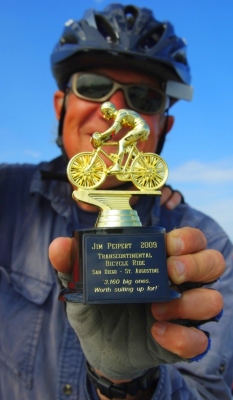





















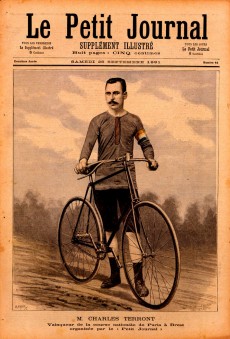












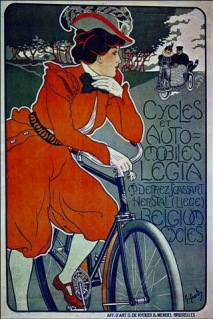
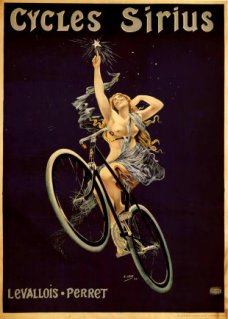




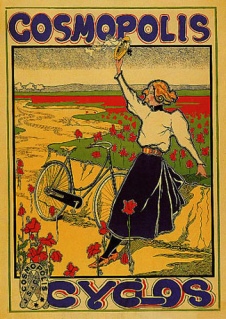










I have a photo taken in early 1900s Kansas of “Russel, Diving Bicyclist” leaping off a ramp into a barrel of water. Have you heard of him?
I have two photos of “Fearless Harvey Sylvester” performing the Max Schreyer feat in 1913.
Joe Schafer